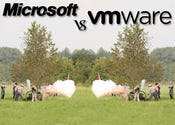Microsoft strengthens its pursuit of the cloud-market crown with its upcoming server software update. Does it do enough to draw businesses into the cloud?


VMware Vs. Microsoft: 8 Cloud Battle Lines
VMware Vs. Microsoft: 8 Cloud Battle Lines (click image for larger view and for slideshow)
In June, Microsoft released a preview of Windows Server 2012 R2, a substantial update that will be for Windows Server 2012 what Windows 8.1 will be for Windows 8. When it was released last year, Windows Server 2012 took a decided turn toward the cloud, and with the new version, Microsoft hopes to advance this agenda by offering scalable tools and services for enterprises of all sizes.
Cloud tools can provide businesses with many benefits, including an empowered mobile workforce, increased licensing and budget latitude, and more agile collaboration among teams in different locations. Even so, businesses face a variety of cloud-adoption obstacles, from the technical complexities of managing cloud resources, to security concerns regarding where sensitive material is hosted, to the scalability that large or growing corporations often need. With Windows Server 2012, Microsoft sought to leapfrog many of these potential stumbling blocks.
Windows Server 2012, which Microsoft characterizes as part of a "cloud OS," was designed to blend onsite servers with Windows Azure's cloud resources, enabling customers to flexibly choose between public, private or hybrid cloud models. Despite sharing Windows 8's Modern UI, Windows Server 2012 has been generally well-regarded, and the R2 version promises a number of important updates.
Improved support for Linux virtual machines (VMs) on Hyper-V is one of the major upgrades. Microsoft, which hasn't always been supportive of Linux, claims that Windows Server R2 will enable "Hyper-V and Windows to be the best cloud for Linux." To bolster this goal, the company is adding support for remote replication of Linux VMs, tools to automatically redistribute memory resources, improved 2-D graphics, and other enhancements intended to make Linux VMs run as well on Hyper-V as Windows ones do.
[ Want to know more about what Microsoft needs to do to turn itself around? See Microsoft's Dilemma: Windows 8.1 May Not Be Enough. ]
Generation 2 VMs are another new feature. The Generation 1 versions that are currently in Windows Server essentially emulate an antiquated PC from the last millennium, but the new ones adopt a more modern 64-bit architecture. It's not clear how much practical difference this will make to many end users, aside from faster boot times and other behind-the-scenes efficiencies. Still, many IT managers will appreciate additions such as expanded disaster recovery and the ability to guarantee given service levels by specifying I/O throughput for a specific VM.
The preview also includes new tools for Windows Server 2012 Essentials, which replaced Windows Small Business. Essentials provides for on-premises server management, but can also be hosted in the cloud or run as a VM, providing customers a variety of deployment options. It is additionally designed to simplify the VM setup process, and to unify management of various tools into a single console, which Microsoft calls the Dashboard. These simplifications could appeal particularly to small and midsize businesses (SMBs), which often lack a dedicated IT staff.
But Windows Server 2012 Essentials isn't aimed just at SMBs. For one thing, improved management consoles are useful even to the largest enterprises, where IT staffers would rather work on business-oriented projects than spend time provisioning VMs. For another, Microsoft will also offer Windows Server 2012 Essentials Experience, a new server role that allows Standard and Data Center version of R2 to take on all the features of all the full versions. The Standard and Data Center packages do not currently enable all Essentials features. Other changes in R2 include support for email distribution groups; mobile device management tools, including remote wipe and policy enforcement controls; SharePoint library management; Windows Azure Active Directory, which includes support for single sign-on to both on-premises and cloud-hosted applications; and tighter integration of Windows Intune and Windows Azure Backup within an overall management Dashboard.
Does R2 add up to a compelling package? Forrester analyst David Johnson thinks so.
"Microsoft has done a brilliant job," he said in a phone interview. "Windows Server provides data center administrators already familiar with Microsoft tools a gateway into the cloud."
Johnson noted that Microsoft has years of expertise managing cloud services, including not only modern products such as Office 365, but also retired services, such as Hotmail. He said the company is now "taking a step forward," with products that provide not only cloud-based storage and collaboration, but also tools to develop applications that can be hosted in Azure, and a bigger role for open-source technology.
Windows Server's outlook is "very positive," Johnson said.
Customers who've only used Microsoft Server as an on-premises resource will need to decide whether they are ready to use it as a launchpad to the cloud. If Microsoft successfully persuades these customers, the ripple effects could be immense, with revenue pouring into not only Windows Server products, but also Office 365, Azure and others. The product promises, in other words, some of the top-to-bottom synergy that CEO Steve Ballmer hopes to achieve with his recent reorganization of the company.
With competitors such as Amazon and VMware making moves of their own, Microsoft's path to victory is not assured. But with a built-in base of Windows Server users and an aggressive cloud strategy, Microsoft could be poised for a surge.
About the Author(s)
You May Also Like







